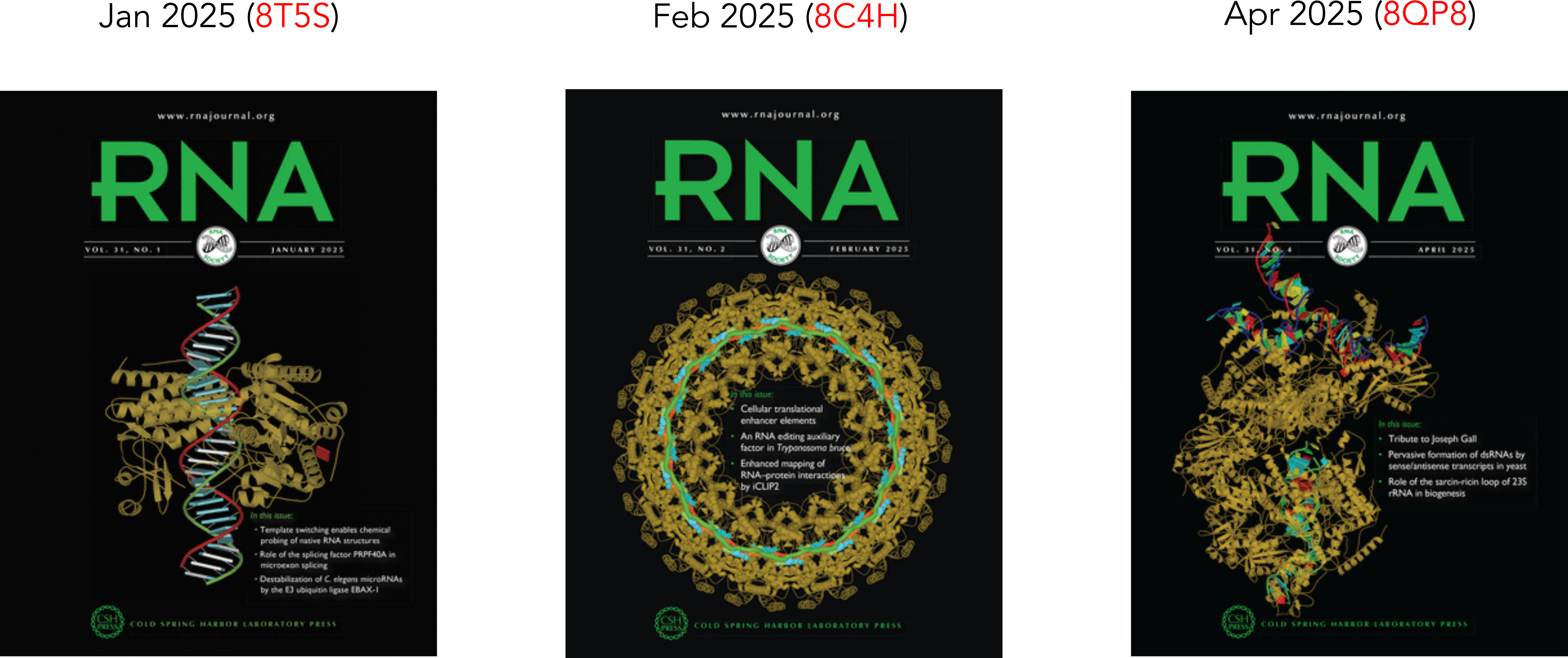Thanks for visiting the X3DNA-DSSR website. With the support from a dedicated NIH grant (R24GM153869), the "3DNA homepage" and the Forum are now alive and actively maintained. What to know more about 3DNA/DSSR? Browse around, and ask questions -- I greatly appreciate all user feedback.
Listed below are news items related to 3DNA/DSSR's further development. The release notes are now available in a PDF file with detailed information on the changes and improvements in each release.
Cover images of the January, February, April, May, and June issues of the RNA journal have been provided by X3DNA-DSSR, an NIGMS National Resource for structural bioinformatics of nucleic acids (R24GM153869; skmatics.x3dna.org). Details on how the images were generated are available.

Hi Xiang-Jun,
Just a small bug report not worth going to the 3DNA forum.
You wrote:
SwS — a Solvation Web Service for Nulceic Acids where 3DNA plays a role.
nucleic is misspelled
Solvation Web Service is better with “web” (small w)
Thanks for that.
Hope that I will be able to show you more soon.
and looking forward to see the new help pages (now that you are working on them).
Also wanted to tell you that up to now, for my needs, 2.1 is working fine.
Best,
Spring is coming
Pascal
— Pascal Auffinger ·
2012-03-27 08:26 ·
#
Hi Pascal,
Thanks for pointing out the nucleic typo — it’s been fixed. Also, I have changed Web to web so it now matches SwS.
It seems this comment should belong to Outside links where SwS and other resources are mentioned.
Xiang-Jun
— xiangjun ·
2012-03-27 09:36 ·
#
The DNA pdb file generated by X3DNA has only A T C G, but no terminal base, e.g. A3, A5, T3, T5, …
How to use X3DNA generate a pdb file with terminal bases?
The reason why I ask this question is because I am using X3DNA to generate initial DNA conformation for MD simulations by Gromacs.
In addition to the above question, is it possible to generate a pdb file that is fully compatible with Gromacs. Now there are some incompatible things. Such as Gromacs using DA, DT, DC, DG, rather than A, T, C, G.
Thanks!
— Dai Liang ·
2016-01-21 03:42 ·
#
Hi Dai Liang,
Thanks for stopping by and making a comment.
First, it is better off to ask such questions on the 3DNA Forum where one can start a new thread with a clearly defined subject line. Here your comment is under the long “What’s new” section which is not directly related to the question asked.
Now, to briefly answer your questions:
- The DNA pdb file generated by X3DNA does not have specific designation of terminal nucleotides, such as A3, A5 etc. These are not standard terminology as far as I can tell, and they do not appear in RCSB PDB entries.
- With the
-pdbv3 option of ‘rebuild’, i.e. rebuild -pdbv3 -atomic, the 3DNA generated PDB file will have DA, DT etc for DNA structures.
- There are several packages for MD simulations, including AMBER, CHARMM, and Gromacs. I am not sure if they all adopt the same input format for PDB files. However, I believe even PDB files directly downloaded from RCSB must go through a preparation step (e.g., adding hydrogen atoms, charge neutralization etc) to be useable in AMBER.
So in your case, you need to do some extra work from 3DNA-gererated PDB files to feed into Gromacs.
Hope this helps.
— Xiangjun ·
2016-01-21 11:30 ·
#
Hi,
I would like to ask whether there is any tool available on X3DNA.org to analyze the DNA base pair type?
Thank you.
— Roshan ·
2018-07-20 03:36 ·
#
Hi Roshan,
Thanks for stopping by and leaving a comment. For the identification and classification of base-pair types (DNA or RNA), please check out DSSR from the 3DNA Forum.
Best regards,
Xiang-Jun
— Xiangjun ·
2018-07-20 07:29 ·
#
Hi,
I was wondering if there is a way to identify non-canonical RNA base pairs from pdb files using X3DNA DSSR. -thank you
— Amir ·
2024-07-19 19:53 ·
#
Hi Amir,
Thanks for stopping by, and sorry for the late response. I’ve not checked comments on this website for quite a while, but I’ll be on alert from now on to respond quickly to user comments.
Yes, DSSR can find non-canonical RNA base pairs from pdb files. See results for 1ehz and the blog post DSSR: Dissecting the Spatial Structure of RNA
Hope this helps.
Xiang-Jun
— xiangjun ·
2024-11-15 23:42 ·
#
« Credits
·
Thank you for printing this article from http://x3dna.org/. Please
do not forget to visit back for more 3DNA-related information. —
Xiang-Jun Lu

